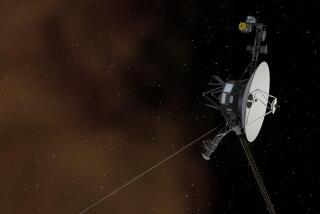Is the latest Mars lander lost? No problem, European Space Agency says

- Share via
Reporting from Berlin — Scientists at the European Space Agency downplayed the likely loss of its Mars lander, saying Thursday that a wealth of data sent back by the experimental probe would help them prepare for a future mission to the Red Planet.
The Schiaparelli lander was designed mainly to test technology for a European robotic mission to Mars in 2020 and avoid the fate of Europe’s Beagle 2 probe, which failed to deploy after landing in 2003.
Data received from Schiaparelli show that it entered the atmosphere as planned Wednesday and used its parachute to successfully slow down in the harsh Martian atmosphere, but its signal was lost shortly before the expected touchdown.
Experts said the probe may have descended too fast or too slowly and hoped that about 600 megabytes of data sent back to Earth would provide answers. The data are equivalent to about 400,000 pages of information for scientists to sift through, they said.
“The experimental test has yielded a huge amount of data and clearly we’re going to have to analyze this in the days and weeks to come, but it gives us a lot of confidence for the future,” said David Parker, ESA’s director of human spaceflight and robotic exploration.
“We need to understand what happened in the last few seconds before the planned landing and that is likely to take some time,” he said.
Getting a spacecraft onto the surface of Mars is notoriously difficult and the planet is littered with the remains of failed attempts. Only NASA has repeatedly succeeded in landing several robotic vehicles on the planet, including the Opportunity and Curiosity rovers.
The apparent failure to achieve what rocket scientists call a “soft landing” marred an otherwise successful start to the ExoMars mission, a joint venture between ESA and Russian space agency Roscosmos.
ESA chief Jan Woerner noted that Schiaparelli’s mother ship was put into orbit around Mars as planned. The Trace Gas Orbiter will analyze the atmosphere to help determine whether there is life on Mars.
ESA’s member states are expected to decide in the coming months whether to put up the estimated 300 million euros ($330 million) needed for the second part of the ExoMars mission in 2020.
Scientists haven’t given up all hope that Schiaparelli might yet phone home. Don McCoy, the manager of the ExoMars project, said attempts will be made to reset the probe’s transceiver but noted that its batteries are only expected to last for a few days.
Parker said his team was undaunted by the fate of Schiaparelli.
“Mars exploration is hard, and that’s one of the reasons we do it,” he said.
More to Read
Sign up for Essential California
The most important California stories and recommendations in your inbox every morning.
You may occasionally receive promotional content from the Los Angeles Times.










